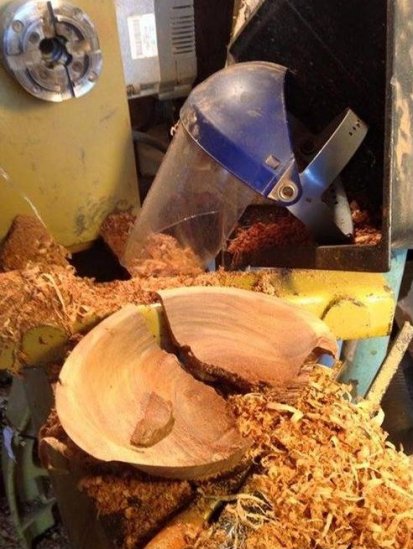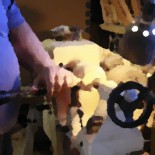Dangerous Conversations.
 By Russell Neyman,
By Russell Neyman,
President, Olympic Peninsula Woodturners.
During the Battle of Britain, when the Royal Air Force went it alone against the formidable German Luftwaffe, the Brits had plenty of fighter planes but were short on experienced pilots. In desperation, they threw hastily trained 18-year-olds into the Mosquitoes and Hurricanes and sent them aloft. That took place in the autumn of 1940, more than a year before the United States entered World War II.
The RAF Command Staff knew the odds were against these new pilots, privately muttering, “If those pilots could somehow last five or ten missions—long enough to learn how to dogfight the Germans—they might have a chance.” Needless to say, the casualty rate for these innocent lads was horrendous. Sometimes I think this applies to woodturners new to the craft; we push them toward the lathe and really don’t brief them about safety. We send them out and hope things turn out. There’s the potential for injury here, and it’s time we were frank about it.
Recently, there have been a handful of naysayers in the national woodworking community warning of the extreme dangers involved in woodturning; I was involved in a discussion on a Facebook Page, “Woodturners From Around the Globe,” that described a bowl breaking apart and flying against the wall. The turner wasn’t injured, but joked about it being a close call. Another turner from Queensland, Geoff Whaling, jumped in with a dark and foreboding warning, citing a serious injury to a woman that occurred in September of 2012.
He contended, “The real facts are that a wood lathe is the most likely machine in a wood shop to actually kill a woodworker [through] a severe head injury complicated by the fact that they are turning in solitude and their injury goes undiscovered for some time…” He made the same point multiple times, arguing with other turners who joined the thread.
After pondering his commentary and responding within the limits of a Facebook format, I went to various Internet sources and I’ll be darned if I could find many deaths caused by working in front of a lathe, and I voiced some skepticism that it was, truly, an activity that presented a threat to our lives. Frankly, I don’t think it is.
Finally, I decided to start my own expanded dialogue on the SawmillCreek.org Turners Forum titled, “Woodturning Deaths?” Geoff, who I have since learned is a longtime woodworker who also has researched safety procedures, eagerly joined this second conversation, and responded:
“Long term I suspect it averages to 1-2 wood turning-related deaths per year in our English-speaking woodturning community. How do I arrive at that figure? It is very difficult to say with any authority due to research data capture methodology. On scene deaths do not appear in hospital admission figures and other data that does record fatalities does not record sufficient data on mechanism of death etc. Some recent confirmed deaths at the wood lathe I have found are Aust in Dec 2012; USA x 2 Apr & May 2011; Canada July 2009. There are a number of metal lathe fatalities and horrific injuries each year. In 2007 I reviewed research from UK (2002 HASS), USA (CDC 2006), Canada & Australia ( ICCWA, QISU, NISU etc) while preparing articles on wood turning safety. Mortality & injury statistics are kept by various medical authorities, however interpreting data pertinent to wood lathe injuries is not easy. Deaths from hobby (or work related) woodturning are insignificant relative to other causes of death. The most relevant research I found relates to injury / death (in hospitals only) from Do It Yourself (DIY). Some of that research includes wood hobbies. The UK HASS data has a national estimate of some 400 lathe injuries (angle grinder 6000, circular saw 3500, chainsaw 1200 pa)”
One or two? That’s a very small number considering that there are, probably, 100,000 serious woodturners, each of whom works at a lathe for 10 to 40 hours a week. Isn’t that less than driving in a car? Even so, he admits that he has no documentation to support his “high” estimate, and for the life of me I can’t find any evidence of frequent deaths. Mind you, both OPCAAW and our Board of Directors take safety seriously, and I am not suggesting that turners should take risks. Geoff makes a couple of good points, but I take exception to his warning that what we do is more dangerous than, say, using a table saw or climbing a ladder.
(Personally, my greatest fear is for the chainsaw, and I’d wager that more woodturners die from chainsaw accidents than any other, if for no other reason than we aren’t as adept at this tool.)
A bruised or lacerated hand? Absolutely.
A wound that required stitches? A broken bone? Possibly.
A death? In my opinion, extremely remote. Almost no chance at all.
The one death that Geoff cited specifically involved a woman who was using a metal lathe and her hair somehow became entangled in the machine. The incident had absolutely nothing to do with pieces of wood flying around the shop. In fact, it wasn’t a woodworking death at all.
The discussion was a healthy one, and dozens of experienced woodturners offered their thoughts. Michigan resident Rich Aldrich had this to say:
“I prefer to have more positive protection. Not only do I use lung protection and a shield, I also use the guard that came with the lathe. I tend to turn a lot of burls, so things come off much more frequently than if turning normal clear wood. Mostly, I use the guard when roughing and starting the finish turn. Once I am making the final finish cuts, I want the guard out of the way so I can see the form uninterrupted by the guard. Guards could be designed better, but until we actually see the value and are willing to pay for a better guard, I doubt we will see any improvements. At this point, I try to practice the line of fire method and normally by this point any weak spot has reared its ugly head and has been remedied. On burls, I use epoxy – instant coffee glue to hold things together. You still need to watch for logs with wind shake or other cracks and weak spots, even if the wood appears to be clear.
“I also think about what I am going to do. Is it safe? Is there a safer way?I really think that the equipment manufacturers should work with us turners and develop a more user friendly guard. If not, maybe engineers like me should take something like this on as a side project and see what we can be developed.”
Another turner, Hilel Salomon of South Carolina, added: ”When a bowl suddenly breaks because of a hidden fault…there is a good possibility of some injury occurring. Using safety equipment and using the tailstock can prevent a lot of ‘misfortune.’” He also advises, “The proper speed is as important the proper equipment.” Both of these are excellent points.
There’s an ironic undertone here. Fear presents its own hazard. Sure, we want woodturners to be aware of the possible risks of using power equipment, but you also need to keep control of the situation. To my way of thinking, a timid, apprehensive individual is more likely to experience a “catch” than one who holds the tool firmly and approaches the wood without flinching. But you can’t be reckless about it, either.
We can’t ignore another obvious fact: the most awe-inspiring turnings would seem to present the greatest possibility of a piece that flies all over the shop. Don’t we admire the vessel with paper-thin walls or the extreme voids? Doesn’t the tone of the artistry encourage us to take chances? Isn’t the piece we consider the best work essentially a high wire act?
It seems to me there’s a risk-reward tradeoff here that is similar to other avocations, like riding a motorcycle, mountain climbing, or snow skiing. Personally, I don’t mind a banged up knuckle every once in a while because I love the results I get. That’s a small price to pay for the satisfaction of working with wood.
Getting back to the analogy of the young British pilots thrown into battle, I also have this observation: that beginning woodturners often jump into the craft without understanding the dynamics of the machine, wood, and tool. They incorrectly conclude that they shouldn’t use “good” wood for practice, throwing a cheap piece of lumberyard fir or cracked firewood onto their lathe and spin away. That can be dangerous! Not life threatening, mind you, but you could be injured.
So, here are a few very broad safety guidelines I would like to offer.
- Know the limits of your lathe. Some machines, such as the pulley-driven units without variable speed mechanisms, do not go slow enough for irregular shapes and get up to speed with a jolt. Consider buying pre-turned bowl blanks or roughing the shape on a bigger lathe.
- Choose wood that is safe to turn. If you elect to turn “natural edge” pieces or those with bark inclusions, be extraordinarily cautious and wear extraordinary protective equipment. Ask a mentor for advice.
- Use all of your senses, including your ears. A cracked bowl sounds differently than a solid one. Vibration – or a sudden change in the rhythm of your project — can often be a warning sign. If something acts differently, turn off the lathe and check things out.
- Use the tailstock even if you don’t think you need it until you have turned off most of the bowl’s mass. Check to see that your faceplate screws are still tight after the first round of roughing a blank.
- Avoid standing in the line of fire – that area directly opposite the “waist” of a bowl blank — especially when you first turn on your lathe. If you have a variable speed lathe, start slow and gradually dial the speed up.
- Wear a mask or other breathing protection equipment. Respiratory problems are a serious consideration.
- Wear a face shield whenever possible, especially if there is any chance that the piece has cracks or splits.
- Keep hair, clothes, and jewelry away from your machine.
- Maintain a well-stocked first aid kit that includes supplies (butterfly sutures, etc) for serious cuts and traumatic injury.
- Keep a cell phone nearby, too, so you can call for help if you need it. If it’s possible to leave a door open to a public avenue, do that so that you can be seen or heard.
Moreover, use common sense, expect the unexpected, and pay attention. Come to think of it, this advice isn’t just for novices; it applies to all of us.
—————————————————-
This article was originally published in the April 2015 issue of CHATTERMARKS, the newsletter of the Olympic Peninsula Woodturners, OPCAAW.com

Nice article Russell. . thanks
LikeLike